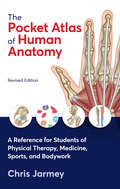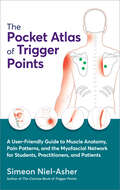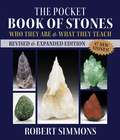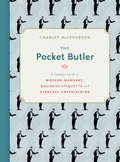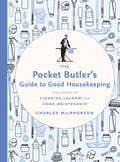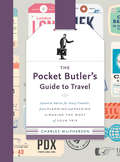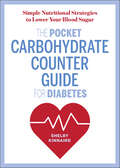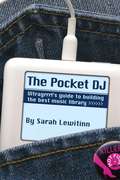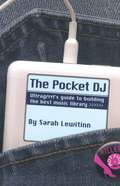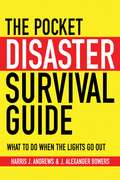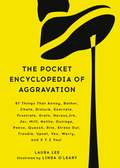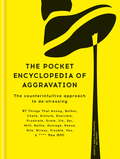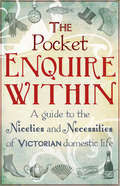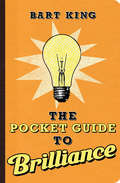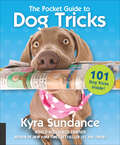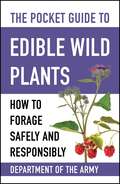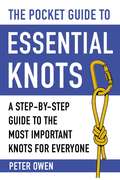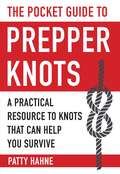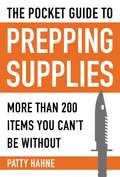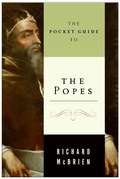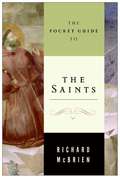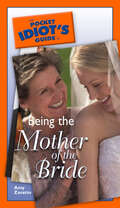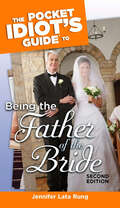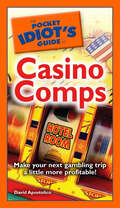- Table View
- List View
The Pocket Atlas of Human Anatomy, Revised Edition: A Reference for Students of Physical Therapy, Medicine, Sports, and Bodywork
by Chris JarmeyRevised and updated: a user-friendly illustrated guide to human anatomy, written for students and practitioners.This concise, pocket-sized guide is a full-color on-the-go reference for students and practitioners of anatomy, massage, physical therapy, chiropractics, medicine, nursing, and physiotherapy. This second edition is more comprehensive, and now includes the skin, and the cardiovascular system, and more. Chapters 1 through 7 explain anatomical orientation, tissues, bones, the axial and appendicular skeletons, joints, and skeletal muscles and fascia. Subsequent chapters detail the four major muscle groups with composite illustrations of each region&’s deep and superficial muscles in both anterior and posterior views. Color tables show each muscle&’s origin, insertion, innervation, and action. A final chapter by Thomas W. Myers outlines myofascial meridians, presenting a map of fascial tracks and illustrating how they wind longitudinally through series of muscles. This new approach to structural patterning has far-reaching implications for effective movement training and manual therapy treatment. Three appendices illustrate cutaneous nerve supply and dermatomes (Appendix 1), the major skeletal muscles (Appendix 2), including detailed charts of the main muscles involved in movement, and the remaining body systems (Appendix 3). &“Impressive artwork throughout—far better than many of the current textbooks.&”—Dr. Robert Whitaker, MA MD MChir FRCS FMAA, Anatomist, University of Cambridge, author of Instant Anatomy, Fifth Edition and A Visual Guide to Clinical Anatomy (Wiley-Blackwell)
The Pocket Atlas of Trigger Points: A User-Friendly Guide to Muscle Anatomy, Pain Patterns, and the Myofascial Network for Students, Practitioners, and Patients
by Simeon Niel-AsherA simple, go-to guide to treating chronic pain with trigger point therapy for physical therapists, bodyworkers, and patients From the bestselling author of The Concise Book of Trigger PointsThis pocket-sized guide covers practical information about the trigger points—the painful knots that can form in tissues like muscles and fascia—that are central to addressing chronic pain with massage, bodywork, and physical therapy. Full-color illustrations and charts help practitioners, students, and patients identify trigger points and address referred pain patterns with ease.The first chapter introduces relevant information on fascia and myofascial meridians and provides an overview of trigger point symptoms, classification, and formation. Subsequent chapters are organized by muscle group and feature concise—yet comprehensive—sections on each of the main skeletal muscles and their trigger points. Conditions that commonly occur in the general population, such as headaches and back pain, are explored for all of the muscle groups, including the muscles of the:Face, head, and neckTrunk and spineShoulder and armForearm and handHip and thighLeg and footWritten in clear, accessible language, this go-to guide offers a wealth of knowledge to the lay reader, the student, or the practitioner.
The Pocket Book of Stones: Who They Are and What They Teach
by Robert Simmons• Features beautifully lit, color photos of each stone to aid in identification and to showcase the beauty of the crystals and gemstones • Provides a description of each stone, a quick-look list of keywords, elemental and chakra correspondences, scientific data, and the story of each stone&’s beneficial physical, emotional, and spiritual qualities • Based on the bestselling The Book of Stones: Who They Are and What They Teach Detailing the spiritual and healing qualities of 390 members of the mineral kingdom, The Pocket Book of Stones is condensed reference guide to crystals and gems based on the bestselling The Book of Stones: Who They Are and What They Teach. This portable A-to-Z guide features beautifully lit, full-color photos of each stone to aid in identification and to showcase the beauty of the crystals and gemstones. This updated edition describes 47 new stones not covered in the original Pocket Book of Stones and contains a comprehensive index of the spiritual, emotional, and healing qualities of the stones. Every entry contains a vivid color photo, quick-look list of keywords, elemental and chakra correspondences, plus the beneficial physical, emotional, and spiritual qualities of each mineral, crystal, or gemstone. Author Robert Simmons provides a description of each stone, including scientific data and the story of each stone&’s spiritual and healing qualities, as well as recommendations for other stones that combine harmoniously with it. The scientific information offered provides a familiar frame of reference for those not yet familiar with crystal energies and also broadens the knowledge of those who come to stones primarily for spiritual purposes. This book provides an ideal introduction to stones and their energies for those who are new to the field as well as an invaluable portable reference for well-versed readers.
The Pocket Butler
by Charles MacphersonYour favourite butler is back with even more advice to help you succeed in etiquette and entertaining! In a fantastic follow-up to his national bestseller, The Butler Speaks, Charles MacPherson lays out the essentials of entertaining and business etiquette in this small, easy-to-follow guide. Now in its third printing, The Butler Speaks has become a go-to resource on household management, manners, and personal style. With a combination of his best tips from the first book and a wealth of new information, The Pocket Butler is the perfect basic overview for anyone looking for that extra edge in business and in life. In addition to revisiting topics such as how to present a business card, shake hands, or set a table, The Pocket Butler offers advice on e-mail and text messaging etiquette, how to set up a modern greeting line in a boardroom, foolproof menu plans for every entertaining scenario, and much more. In his signature unfussy and approachable style, Charles shows how modern manners are more important than ever before, not only for those just entering the workforce, but for all professionals at any stage in their careers.
The Pocket Butler's Guide to Good Housekeeping: Expert Advice on Cleaning, Laundry and Home Maintenance (Pocket Butler)
by Charles MacPhersonEveryone's favourite butler is back! Get your home spic and span with Charles MacPherson's expert tips and tricks for everything from polishing silverware to organizing the garage.After over 30 years as a professional butler and household manager, Charles MacPherson knows a thing or two about keeping a home clean and organized. He has poured his vast knowledge and expertise into this pocket-sized volume, perfect for easy day-to-day reference or to guide your next marathon cleaning session.Everything you need to know is here. With step-by-step instructions for cleaning, organizing, and maintaining every room in your home, The Pocket Butler's Guide to Housekeeping comprises information-packed chapters on cleaning, laundry, organization, and more. Wondering how to tackle a fresh stain? Looking for recipes for natural and gentle cleaning products? Want to finally master those crisp hospital corners for making your bed? Look no further than this definitive cleaning caddy companion.With handy checklists for daily, weekly, monthly, and annual cleaning; a complete guide to laundry symbols and fabric types; advice for hosting guests; and even tips for dealing with pests, damage, and long-term maintenance, this is a volume no home should be without.
The Pocket Butler's Guide to Travel: Essential Advice for Every Traveller, from Planning and Packing to Making the Most of Your Trip (Pocket Butler)
by Charles MacPhersonIndispensable travel advice from Everyone's Favourite ButlerA world authority on the art of travel, Charles MacPherson has planned itineraries for celebrities and business leaders, and trained the staff of some of the world's leading hotels. In this easy-to-follow guide, you will find his tips on how to: * Plan Your Trip: choose luggage and accommodations, master wrinkle-free packing, secure an upgrade and manage your schedule. * Travel in Style: for business or pleasure; by plane, train, cruise ship, coach, yacht, car or even private jet. * Make the Most of Your Stay: get help from the concierge (every hotel's best-kept secret) and navigate international dining etiquette and tipping culture. And much more! Slip this compact book into your carry-on luggage for a trusted companion wherever your travels may take you.<
The Pocket Carbohydrate Counter Guide for Diabetes: Simple Nutritional Strategies to Lower Your Blood Sugar
by Shelby KinnairdThe Pocket Carbohydrate Counter Guide for Diabetes offers the simplest, most accurate strategies for counting carbs and lowering your blood sugar.When you have a strategy for counting carbohydrates, you don't need to consult lists of nutritional information every time you sit down to eat. The Pocket Carbohydrate Counter Guide for Diabetes makes it easy to manage diabetes in your daily life with simple nutritional strategies to accurately count carbs and maintain normal blood sugar levels.Written for recently-diagnosed and long-time diabetes patients alike, this handy pocket reference is a simple solution to eliminate guesswork and confidently judge the carbs in every meal. From setting targets and finding your personal sweet spot, to actionable strategies like meal planning, this carbohydrate counter book makes counting carbs as easy as 1,2,3.Never overestimate or underestimate carbs again. This carbohydrate counter book keeps your blood sugar levels in check with:Effective tools for counting carbs with clear, step-by-step instructions and illustrations for accurately measuring carbs, plus alternative methods such as meal planning and balancing your plateLifestyle advice that includes recommendations for smart snacking, and offers tips on what to order while eating outAn introduction on the connection between carbs and diabetes that provides an in-depth look at what happens in your body when you eat carbs, and an overview of foods that contain (and hide) carbsStop guessing—learn simple strategies for counting carbohydrates and lower your blood sugar with this carbohydrate counter book.
The Pocket DJ
by Sarah LewitinnWith more than two thousand songs handpicked and organized by former Spin magazine writer and editor Sarah Lewitinn (aka Ultragrrrl), The Pocket DJ is the ultimate insider's reference guide for selecting music, downloading MP3s, and making all-purpose mixes for every occasion imaginable
The Pocket DJ
by Sarah LewitinnWith more than two thousand songs handpicked and organized by former Spin magazine writer and editor Sarah Lewitinn (aka Ultragrrrl), The Pocket DJ is the ultimate insider's reference guide for selecting music, downloading MP3s, and making all-purpose mixes for every occasion imaginable. Playlists include: Essential genres: with crowd-pleasing dance mixes for indie rockers, headbangers, and hip-hop lovers alike Essential artists: with the best songs by all the greats from the Beatles to Björk Celebrity playlists: featuring Duran Duran, Smahing Pumpkins, Interpol, and Good Charlotte, among others Other playlists: with tunes for working out, making out, or rocking out Plus rock trivia, new music recommendations, DJing tips, Web resources, and more!
The Pocket Disaster Survival Guide: What to Do When the Lights Go Out
by Harris J. Andrews J. Alexander BowersWhether it’s a hurricane bearing down on a home near the coast or a power line downed in a snowstorm near a car, are you prepared for these situations? This slim handbook will provide you with all the information you need to ensure that you, your family, and your pets can weather any emergency crisis. Learn the necessity of backing up important documents, how to safely store food and water for more than a day, and how to communicate with your family and emergency personnel should a disaster strike.
The Pocket Encyclopedia of Aggravation: 97 Things That Annoy, Bother, Chafe, Disturb, Enervate, Frustrate, Grate, Harass, Irk, Jar, Miff, Nettle, Outrage, Peeve, Quassh, Rile, Stress Out, Trouble, Upset, Vex, Worry, and X Y Z You!
by Laura Lee Linda O'LearyThe Pocket Encyclopedia of Aggravation is an A-to-Z illustrated compendium of everyday annoyances--from airline legroom, missing socks, and knuckle cracking to video buffering, telemarketers and internet trolls--complete with truly informative scientific explanations and wry commentary.This collection of 100 headaches, day-ruining events, moment destroying mishaps and infuriating everyday aggravations presents the fascinating facts behind the world's most frustrating situations. Laura Lee's dry, humorous and scientific text explains why fingernails on the chalkboard make you cringe; why people drive slowly in the fast lane; why dripping faucets annoy women more than men; why the other line is always faster than the one you are on; and more. She also gives tips on how to deal with annoying things like brain freeze, hangnails, and that coworker that wears too much perfume. Amazingly, some things are less annoying when you know the facts. Redesigned with enlightening diagrams and witty drawings, The Pocket Guide of Aggravation, finally answers the question, why is that so annoying?
The Pocket Encyclopedia of Aggravation: The Counterintuitive Approach to De-stressing
by Laura LeeAaarghgghhh!!@#%&*!!! Every time your mobile phone rings, it's an automated PPI call... You've forgotten one of your million different internet passwords... Once again, you're stuck in the slowest lane at the supermarket...This book investigates 97 day-ruining events, slap-in-the-face moments and everyday aggravations, and explains why these things irritate us quite so much. Let's face it, the world is becoming an increasingly annoying place to live - and THE POCKET ENCYCLOPEDIA OF AGGRAVATION has the evidence to prove it. It has been scientifically proven that when we understand the science behind our daily grievances, our problems become less frustrating and easier to manage. This fact-filled book will help reduce the stress of your daily grind. Designed with enlightening diagrams and witty drawings, THE POCKET ENCYCLOPEDIA OF AGGRAVATION finally answers the question, why is that so f*cking annoying?
The Pocket Enquire Within: A guide to the niceties and necessities of Victorian domestic life
by George ArmstrongWhat is the correct way to carve a partridge?How should leeches be applied?How can egg whites be used to repair broken china?First published in 1856, Enquire Within rapidly became the indispensable guide to Victorian domestic life. Packed with words of wisdom and pithy advice, it covered everything from entertaining and etiquette to household management, and took in considered discussion of such arcane matters as how singing might prevent consumption, and which ointments will remove freckles, not to mention why chess should on no account ever be played at a ball.This new, charmingly illustrated pocket-sized edition contains a selection of hints and tips that not only provide a fascinating insight into the day-to-day life of Victorian Britain, but also, in places, reveal timeless wisdom that we would do well to heed today.
The Pocket Guide to Brilliance (Pocket Guide To Ser.)
by Bart KingThe author of Dad Humor offers an entertaining look at American history&’s geniuses, leaders, and dunderheads in a clever quest to define brilliance. With dry humor and a wealth of fascinating trivia, Bart King explores what it means for a person to be brilliant. What he discovers is that brilliant people are those who walk farther, think deeper, and talk louder than the rest of us. They do what it takes to get the job done—and then some. The masters of brilliance profiled here include presidential candidate John Lindsay, who released chickens into his opponent&’s crowd to spur on a debate; the first female journalist, Anne Newport Royall, who forced an interview with John Quincy Adams after catching him skinny dipping; and Benjamin Franklin, who of course coined the phrase "A penny saved is a penny earned," but also offered the lesser known "A man who lives on hope, dies farting."
The Pocket Guide to Dog Tricks
by Kyra SundanceFrom the author of 101 Dog Tricks, an international bestseller with over a half million copies sold, a pocket-sized edition for impromptu training.Who says your dog can’t learn new tricks? The Pocket Guide to Dog Tricks gives you all the instruction you’ll need to get your pup in shape. This handy pocket guide features step-by-step instructions with easy-to-follow color photos.Tricks range from simple classics like Sit, Shake Hands, Fetch, and Roll Over, to extraordinary ones like Tidy Up Your Toys into the Toybox, and Get a Soda from the Fridge. Millions of people have found success with Kyra Sundance’s step-by-step techniques—and you will too.Trick training will help you bond with your dog and integrate him or her into your family. Tricks keep your dog mentally and physically active and help to establish paths of communication between you.This convenient guide is perfect for traveling, a trip to the dog park, or to keep in a bag for on-the-go training.
The Pocket Guide to Edible Wild Plants: How to Forage Safely and Responsibly (Pocket Guide)
by U.S. Department of the ArmyNow outdoorsman and survivalists can own this comprehensive and handy guide to edible plants authored by the US Army. Whether you are a stranded soldier, a wilderness hiker, or you just want to know which plants growing in your backyard are edible, this is an invaluable resource. Nothing is more important for the outdoorsman than being prepared to survive in the wild, and the ability to recognize edible plants is an indispensable way to do so. When survival is the chief objective, often plants are one&’s best (and only) source of nutrition and medicine. The key is being familiar with their botanical structure, where to find them, and which will provide the most sustenance. Equally as important is knowing which are potentially poisonous or fatal if consumed. This is a full-color reference to plants both common and rare, from purslane to the prickly pear. Inside are details on how to locate, identify, and prepare edible wild plants, as well as information on their specific nutritional benefits and other handy uses. This guide also includes a section on which plants to avoid and how to test for edibility. A no-nonsense survival aid, this book is an essential guide for serious adventurers and the armchair botanist alike. Anyone who has spent serious time outdoors knows that in survival situations, wild plants are often the only sustenance available. The proper identification of these plants can mean the difference between survival and death.
The Pocket Guide to Essential Knots: A Step-by-Step Guide to the Most Important Knots for Everyone
by Peter Owen21 Essential Knots for Everyday Use Indoors or Outdoors! This compact little reference book includes knots for a wide range of functions, from home to work, hobby to play activities. No knot-tying jargon is used, no baffling technical terms—just simple step-by-step instructions and outstandingly clear line drawings. It's the perfectly portable knot reference for anyone—scouts, sailors, hunters, anglers, gardeners, farmers, horse riders, you name it! Among the knots in this book are: Overhand knotHeaving line knot Reef knotSheetbend Fisherman&’s knot, Figure-of-eight loop Bowline Three-part crown Sheepshank Half-hitch Clove hitch,Constrictor knot Pile hitch Highwayman&’s hitchWaggoner&’s hitch Timber hitchDouble-loop knotUni-knotBlood knotSquare lashing And more! Start learning these useful and practical knots today with The Pocket Guide to Essential Knots.
The Pocket Guide to Prepper Knots: A Practical Resource to Knots That Can Help You Survive (Pocket Guide)
by Patty HahneKnowing the ropes when a catastrophic situation strikes can be the key to survival, and in The Pocket Guide to Prepper Knots, Patty Hahne demonstrates the most important multi-purpose knots preppers should be prepared to know. Illustrated with step-by-step instructions for tying them and the knots being used in various situations, the book covers such topic as:•The uses for various types of ropes as well as their advantages and disadvantages•How putting a knot in a rope affects its overall strength•Why being proficient in a few multi-purpose knots is more beneficial than being vaguely familiar with a large number of knots•And much moreThe Pocket Guide to Prepper Knots is a valuable addition to any prepper’s book collection. Its compact design makes it easy to carry in a purse or pocket, stored in the car, or slipped into a bug-out bag.
The Pocket Guide to Prepping Supplies: More Than 200 Items You Can?t Be Without
by Patty HahneYou will need more than just food and water when the grid goes down.Many people know what they need to survive a doomsday scenario. They stock high-calorie foods and clean water, they find their own sources of power and heat, and they prepare to defend themselves, if need be. With all they have stored, they have the ability to survive for days, even months at a time.You may think you have finished preparing once you have accumulated these basic necessities, but there is always more that can be done. In The Pocket Guide to Prepping Supplies, Patty Hahne offers up two hundred and thirty-five oft-forgotten items that may prove to be indispensable for surviving the apocalypse-should it happen. From the mundane, like quality shelving and needle and thread, to more specialized tools, such as a closet auger and jumper cables, Hahne describes how each one can prove to be a vital addition to the prepper’s cache. You may be surprised to see what common household items can do when used creatively, and Hahne is here to help inspire you.Presented in a compact design, The Pocket Guide to Prepping Supplies is an important addition to any prepper’s book collection, one that can be carried in a purse or pocket, stored in the car, or slipped into that carefully prepared bug-out bag.
The Pocket Guide to Wild Mushrooms: Helpful Tips for Mushrooming in the Field
by Pelle Holmberg Hans MarklundWhen you're in the wild and you spot a nice-looking mushroom, how do you know if it is safe to eat? Question no more with the The Pocket Guide to Wild Mushrooms. This tiny companion is the perfect book to bring along when foraging for delectable fungi. Inside its neatly arranged pages are fifty-two edible mushrooms as well as the mushrooms with which they are often confused, whether edible or toxic.Beautiful photographs adorn the pages with mushrooms in the wild as well as picked, showing them from a multitude of angles. Study these photographs and you will become adept at recognizing edible and safe mushrooms. Even those who are unfamiliar with the mushroom forest can make a start at foraging with this instructional work, and, with the help of The Pocket Guide to Wild Mushrooms, can become experts in no time.Using practical symbol systems, distribution maps, and tips on picking, cleaning, cooking, and canning, the reader will also become familiar with a wide variety of wild mushrooms, including morels, black trumpets, chanterelles, sheep polypore, porcini, a variety of boletes, and many more. Grabbing this guide on the way out to go hunt for mushrooms will ensure a successful foraging experience.
The Pocket Guide to the Popes
by Richard P. McbrienThis pocket edition of Richard McBrien's acclaimed Lives of the Popes is a practical quick reference tool for scholars, students, and anyone needing just a few concise facts about all the popes, from St. Peter to Benedict XVI.
The Pocket Guide to the Saints
by Richard P. McbrienThis pocket edition of Richard McBrien's Lives of the Saints is the perfect concise, handy reference for scholars, students, and general readers.
The Pocket Idiot's Guide to Being The Mother Of The Bride
by Amy ZavattoBeing the mother of the bride is a full-time job, often with little or no thanks. With the help of this guide, mothers-in-law-to-be can now tackle the seemingly endless details with calm. Inside, you will find what is to be expected of the mother of the bride (and all the role&’s no-nos), ways to dissolve the stress around her and reduce her own tension, tips on being the best mother-in-law any groom has ever had, and how to help the bride avoid sticky family situations. Filled with words of wisdom from mothers of the bride who have lived to tell the tale, it&’s a great gift idea for the bride to give to her mother.
The Pocket Idiot's Guide to Being the Father of the Bride, 2nd Edition
by Jennifer Lata RungWhen his little girl is getting married. . . . The Pocket Idiot&’s Guide to Being the Father of the Bride, second edition, covers everything every bride&’s father needs to know to make it from engagement to honeymoon with his sanity—and, if he&’s lucky, his wallet—intact. Written with the interests of the bride in mind, this new edition provides nervous fathers with a new chapter on how to make a memorable wedding day toast, complete with several sample speeches.
The Pocket Idiot's Guide to Casino Comps: Make Your Next Gambling Trip a Little More Profitable!
by David ApostolicoAlways a winner! Before you lay down a lot of money at the tables and machines in casinos, you should also consider all of the freebies you can get from simply being there. Casinos give away over one billion dollars a year in free stuff to valued customers. From the high-roller level of suites, meals, and credit to the small-time repeater gamblers with discounts on meals, transportation, and shows, there are hundreds of ways to make a visit to the casino profitable—without spending a dime. Dave Apostolico, poker and gambling expert, explains how gamblers can get paid to play, which casinos have the best comps, inside rules that work to your advantage, and the ideal games for comps, special promotions, discounts, and credit.
